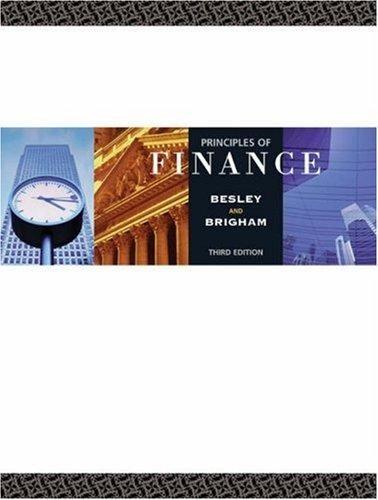Question
4. Suppose that a stock gave a realized return of 20% over a two-year time period and a 10% return over the third year. The
4. Suppose that a stock gave a realized return of 20% over a two-year time period and a 10% return over the third year. The geometric average annual return is ________. (2 points)
A) 8.28%
B) 12.43%
C) 14.08%
D) 16.57%
5. Bear Stearns' stock price closed at $98, $103, $58, $29, $4 over five successive weeks. The weekly standard deviation of the stock price calculated from this sample is ________. (2 points)
A) $30.07
B) $49.40
C) $42.96
D) $34.37
6. The average annual return over the period 1926-2009 for the S&P 500 is 12.0%, and the standard deviation of returns is 21.3%. Based on these numbers, what is a 95% confidence interval for 2010 returns? (2 points)
A) -1.5%, 21.8%
B) -10.7%, 32.8%
C) -30.6%, 54.6%
D) -30.6%, 76.4%
7. Consider the following average annual returns:
| Investment | Average Return |
| Small Stocks | 23.8% |
| S&P 500 | 13.1% |
| Corporate Bonds | 7.5% |
| Treasure Bonds | 6.8% |
| Treasury Bills | 4.9% |
What is the excess return for corporate bonds? (2 points)
A) 2.6%
B) 1.3%
C) 5.2%
D) 0%
8. Big Cure and Little Cure are both pharmaceutical companies. Big Cure presently has a potential "blockbuster" drug before the Food and Drug Administration (FDA) waiting for approval. If approved, Big Cure's blockbuster drug will produce $1 billion in net income for Big Cure. Little Cure has ten separate, less important drugs before the FDA waiting for approval. If approved, each of Little Cure's drugs would produce $50 million in net income. The probability of the FDA approving a drug is 50%.
What is the expected payoff for Little Cure's ten drugs? (2 points)
A) $250 million
B) $50 million
C) $1 billion
D) $0
9. Consider an economy with two types of firms, S and I. S firms always move together, but I firms move independently of each other. For both types of firms there is a 20% probability that they will have a 20% return and a 80% probability that they will have a -30% return.
What is the expected return for an individual firm? (2 points)
A) -12%
B) -20%
C) 10%
D) 20%
10. Consider an economy with two types of firms, S and I. S firms always move together, but I firms move independently of each other. For both types of firms there is a 70% probability that the firm will have a 20% return and a 30% probability that the firm will have a -30% return.
The standard deviation for the return on an portfolio of 20 type S firms is closest to ________. (3 points)
A) 13.75%
B) 22.91%
C) 5.00%
D) 4.58%
11. Consider the following returns of a portfolio:
Jan2% Feb 5% Mar -6% Apr 3% May -2% Jun 4%
- Calculate the arithmetic average monthly return (1 point)
- Calculate the geometric average monthly return (1 point)
- Calculate the monthly variance (2 points)
Step by Step Solution
There are 3 Steps involved in it
Step: 1

Get Instant Access to Expert-Tailored Solutions
See step-by-step solutions with expert insights and AI powered tools for academic success
Step: 2

Step: 3

Ace Your Homework with AI
Get the answers you need in no time with our AI-driven, step-by-step assistance
Get Started


